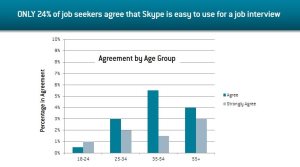Freezing Out Your Candidates?

In my area of focus, though, it’s much less common for the HR consumer to realize the difference. Video interviewing today is still confused with consumer-level video tools by talent acquisition leaders and recruiters. Many think it’s the same as using Skype. In fact, research commissioned this summer asked 100 panelists if they were aware of any video interviewing technology that has been purpose-built for hiring. Only 44 percent said “yes.” The respondents were all talent acquisition and HR leaders with decision-making authority for talent acquisition products and services. That means nearly 60 percent are judging the concept of video interviewing based on a consumer-level tool.
Skype is fine, but. . . .
Skype is a fine way to start exploring the core benefits of video in the interview process, but be mindful of what you’re doing to your job candidates. While they are vulnerable, nervous, and eager to impress, you are putting this extra requirement upon them, and they are completely on their own. And guess what? Skype is not that easy to use.

In one small, funny way, the choppiness of the Skype connection may lend some help to the job candidate. This recent article points to an extremely inventive job candidate who actually used the on-and-off freeze-ups to his advantage. When the recruiter asked a question that stumped him, he purposely froze for a few seconds to buy himself some time. He heard the recruiter saying, “Billy, did I lose you?” and then resumed his motion and speaking once he felt better prepared to answer the question.
A choppy experience, low ease of use ratings, and no support to call for assistance: Sounds like a recipe for candidate experience disaster. Yet, its use is prevalent throughout HR departments. There is room for clarification and education in video interviewing that will help HR decision-makers and users separate the consumer-level tools from the purpose-built solution once and for all. While those consumer tools can provide a reactive answer for very basic video, they lack the branding, consistency, quality and security required by established organizations with mature HR functions. Most of all, they do not deliver the experience that your job candidates deserve, and ever more frequently, demand.

